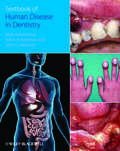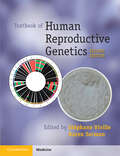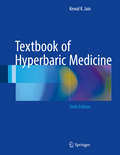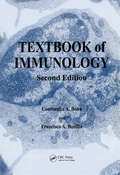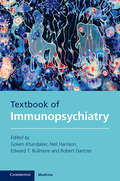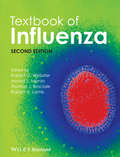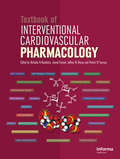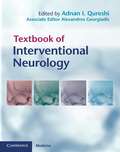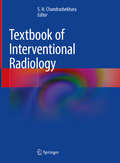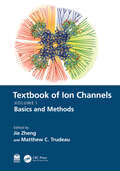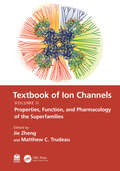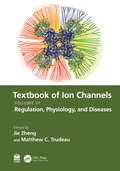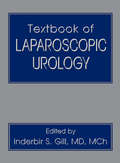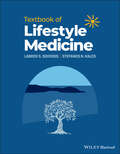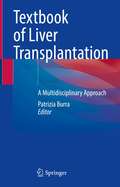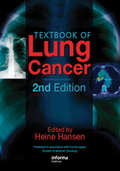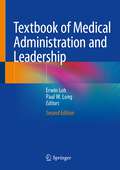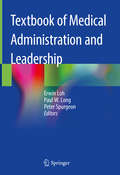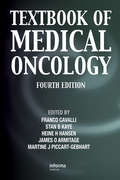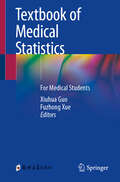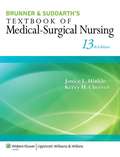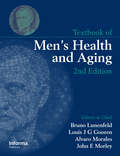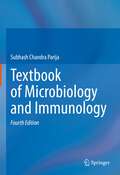- Table View
- List View
Textbook of Human Disease in Dentistry
by Mark Greenwood Robin Seymour John MeechanThe Textbook of Human Disease in Dentistry is a comprehensive resource for all students of dentistry that provides uniquely integrated coverage of medicine, surgery, pharmacology, therapeutics, pathology and microbiology. It aims to provide its readers with the medical context of dentistry, to promote better understanding of how to provide effective dental treatment to patients affected by diseases and conditions. The Textbook of Human Disease in Dentistry is structured around the systems of the body and includes chapters on immunological disease, cardiovascular diseases, respiratory medicine, gastroenterology, dermatology, musculoskeletal disorders and neurological and special senses. A key aspect of the book is the relevance of particular diseases and/or their drug treatment to dentistry and in turn to patient dental management. Additional chapters are therefore provided on topics such as clinical examination and history taking, inflammation and anti-inflammatory drugs, infection control, pain and anxiety control, and care of the elderly. Filled with useful features and written in a lucid and accessible style, this book will provide its readers with a sound and accessible grounding in human diseases and their drug treatment and how they relate to dental care. Includes sections on all major diseases and conditions, describing aetiology, symptoms and treatment Places dentistry in a medical context, providing guidance on examination and treatment protocols Features information on drug treatment and planning dental care around it Illustrated with helpful clinical photographs, showing diseases and conditions
Textbook of Human Reproductive Genetics
by Stéphane Viville Karen D. SermonA basic understanding of human genetics is vital for all those working in the field of assisted human reproduction. Genetic makeup can hamper reproduction and insight into this is making genetic diagnosis and counselling increasingly important. This fully updated textbook continues the clear structure of the original edition, beginning with a chapter on the basics of genetics and cytogenetics. Genetic causes of infertility and the effect of epigenetics and transposons on fertility are discussed in detail. Several new chapters are included in this edition, reflecting the advances of the field, including preconception genetic analysis and screening in IVF and mitochondrial genetics. Combining genetics, reproductive biology and medicine, this is an essential text for practitioners in reproductive medicine and geneticists involved in the field looking to improve their knowledge of the subject and provide outstanding patient care.
Textbook of Hyperbaric Medicine
by Kewal K. JainThis comprehensive volume captures the latest scientific evidence, technological advances, treatments and impact of biotechnology in hyperbaric oxygen therapy. Divided into three distinct sections, the book begins with basic aspects that include history, equipment, safety and diagnostic approaches; this is followed by clinical applications for hyperbaric oxygen therapy in various modalities; the last section provides an overview of hyperbaric medicine as a specialty with best practices from around the world. Integration of multidisciplinary approaches to complex disorders are also covered. Updated and significantly expanded from previous editions, Textbook of Hyperbaric Medicine, 6th Edition will continue to be the definitive guide to this burgeoning field for students, trainees, physicians and specialists.
Textbook of Hyperbaric Medicine
by Kewal K. JainThis comprehensive volume captures the latest scientific evidence, technological advances, treatments and impact of biotechnology in hyperbaric oxygen therapy. Divided into three distinct sections, the book begins with basic aspects that include history, equipment, safety and diagnostic approaches; this is followed by clinical applications for hyperbaric oxygen therapy in various modalities; the last section provides an overview of hyperbaric medicine as a specialty with best practices from around the world. Integration of multidisciplinary approaches to complex disorders are also covered.Updated and significantly expanded from previous editions, Textbook of Hyperbaric Medicine, 6th Edition will continue to be the definitive guide to this burgeoning field for students, trainees, physicians and specialists.
Textbook of Immunology
by Constantin A. Bona Francisco A. BonillaBuilding on the strengths of the first edition, the newly titled and expanded second edition remains a concise introduction to the fundamentals of immunology, with an expert synthesis of basic and clinical information., Augmented by color illustrations, and with increased emphasis on the molecular and genetic underpinnings of cellular phenomena, Textbook of Immunology covers the physiology of the immune system, disease entities related to immune system dysfunction, and the underlying pathophysiologic mechanisms of dysfunction. In response to advancing knowledge that influences the approach to presenting basic immunology, new chapters have been added on cytokines; host defense (non-specific immunity and specific immune responses); the aging immune system; and the pathophysiology, diagnosis, prevention, and therapy of AIDS., This book keeps pace with the explosion of information and data in immunology, and adeptly refines, organizes, and presents this body of knowledge to serve as a succinct introduction to modern immunologic concepts for medical students, and as an update and refresher in the basics for researchers and clinicians.
Textbook of Immunopsychiatry
by Golam Khandaker Neil Harrison Edward Bullmore Robert DantzerThe rapidly growing field of immunopsychiatry combines expertise and insights from immunology, psychiatry and neuroscience to understand the role of inflammation and other immune processes in causing and treating mental illness. This represents a major shift in mental health science, traditionally focused on psychological and neuronal mechanisms of depression, psychosis and dementia. This book provides the first comprehensive overview of recent, inter-disciplinary research linking disordered function of the immune system to the brain and mental illness. It offers a broad and deep perspective on the implications of immune system involvement in psychiatric disorders, including a balanced focus on basic science and clinical applications. Chapters cover the scientific evidence linking immune processes to major mental illnesses such as schizophrenia, depression, anxiety and dementia. An invaluable guide for graduate students, doctors in training, scientific researchers and others interested in the link between the immune system and mental health.
Textbook of Influenza
by Arnold S. Monto Robert G. Webster Thomas J. Braciale Robert A. LambThe Textbook of Influenza is a comprehensive resource covering all aspects of influenza, from the genetic and molecular biology of the virus through to clinical aspects of the disease and the latest drug developments and treatments. This new edition has been completely revised and reflects the integration of disciplines concerning the emergence, evolution, pathogenesis and control of influenza viruses in the field of human and veterinary public health.Textbook of Influenza examines the lessons learnt from the latest pandemic and provides the current state of knowledge for many yet unresolved issues related to virus origin, spread, pathogenesis and disease severity to better prepare for future pandemics. It covers the background to recent advances in influenza genomics and reverse genetics which have allowed the identification of virus virulence factors and the analysis and reconstruction of influenza viruses such as the 1918 Spanish flu strain.This new edition is divided into eight key sections, containing chapters co-written by international experts from both the clinical and scientific communities, covering:* Influenza Perspectives* Structure and Replication* Evolution and Ecology* Epidemiology and Surveillance* Immunology* Vaccines and Vaccine Development* Clinical Aspects and Antivirals* Public HealthTextbook of Influenza is for all those working in the area of influenza including clinical and basic scientists, immunologists, molecular and structural virologists, public health officials and global pandemic control planners.
Textbook of Interventional Cardiovascular Pharmacology
by Nicholas N. Kipshidze Jawed Fareed Jeffrey W. Moses Patrick W. SerruysWhile all interventional cardiologists have access to pharmacopeial texts and databases and are aware of the growing number of pharmacological agents in the armamentarium, questions arise as to the ideal agent or combination of agents in differing patient situations. This superb text offers the reader coverage of all the major pharmacological t
Textbook of Interventional Neurology
by Adnan I. Qureshi Alexandros L. Georgiadis"Endovascular intervention - using medication and devices introduced through catheters or microcatheters placed into the blood vessels through a percutaneous approach - has emerged as a relatively new minimally invasive approach to treat cerebrovascular disease and possibly intracranial neoplasms. This textbook provides a comprehensive review of principles pertinent to endovascular treatment of cerebrovascular diseases and intracranial tumors, with a detailed description of techniques for these procedures and periprocedural management strategies. Particular emphasis is placed on expert interpretation of the quality of evidence provided and implications for practice related to endovascular procedures. This will be essential reading for clinicians working in interventional neurology and cardiology, endovascular neurosurgery, vascular surgery and neuroradiology"--Provided by publisher.
Textbook of Interventional Radiology
by S. H. ChandrashekharaThe textbook covers all the aspects of interventional radiology (IR), ranging from anatomy, pre-procedural evaluation, technique, post procedure care, and complications. It provides a comprehensive overview of both vascular and non-vascular interventions and thus fills the gap in the existing literature. The Initial chapters of the book focus on the hardware, drugs, contrast media, and imaging systems used in IR enabling the reader to become oriented to the interventional techniques that are covered in the subsequent chapters. Each chapter in the book focuses upon a particular set of interventions on an organ or organ system from head to toe, thereby facilitating convenient reading by the users. This book is designed not only to guide trainees enrolled in super-specialty and fellowship courses in interventional radiology (IR) but also to offer foundational IR training for general radiologists, effectively bridging the gap between general radiology and IR. It equips trainees with all the essential knowledge needed to practice IR and prepare for exams such as FRCR, EDiR, RANZCR, DM, and fellowship examinations. Additionally, it serves as a valuable reference for both practicing general radiologists and interventional radiologists. The book is relevant for MD/DNB trainees in radiology/radiodiagnosis, DM/DNrB trainees in interventional radiology/ neuroradiology/ cardiovascular radiology, and fellowship trainees in interventional radiology and its subspecialties.
Textbook of Ion Channels Volume I: Fundamental Mechanisms and Methodologies
by Jie Zheng Matthew C. TrudeauThe Textbook of Ion Channels is a set of three volumes providing a wide-ranging reference source on ion channels for students, instructors and researchers. Ion channels are membrane proteins that control the electrical properties of neurons and cardiac cells; mediate the detection and response to sensory stimuli like light, sound, odor, and taste; and regulate the response to physical stimuli like temperature and pressure. In non-excitable tissues, ion channels are instrumental for the regulation of basic salt balance that is critical for homeostasis. Ion channels are located at the surface membrane of cells, giving them the unique ability to communicate with the environment, as well as the membrane of intracellular organelles, allowing them to regulate internal homeostasis. Ion channels are fundamentally important for human health and diseases, and are important targets for pharmaceuticals in mental illness, heart disease, anesthesia, pain and other clinical applications. The modern methods used in their study are powerful and diverse, ranging from single ion-channel measurement techniques to models of ion channel diseases in animals, and human clinical trials for ion channel drugs.Volume I, Part 1 covers fundamental topics such as the basic principles of ion permeation and selectivity, voltage-dependent, ligand-dependent, and mechano-dependent ion channel activation mechanisms, the mechanisms for ion channel desensitization and inactivation, and basic ion channel pharmacology and inhibition. Volume I, Part 2 offers a practical guide of cardinal methods for researching ion channels, including heterologous expression and voltage-clamp and patch-clamp electrophysiology; isolation of native currents using patch clamping; modeling ion channel gating, structures, and its dynamics; crystallography and cryo-electron microscopy; fluorescence and paramagnetic resonance spectroscopy methods; and genetics approaches in model organisms.All three volumes give the reader an introduction to fundamental concepts needed to understand the mechanism of ion channels; a guide to the technical aspects of ion channel research; a modern guide to the properties of major ion channel families; and includes coverage of key examples of regulatory, physiological and disease roles for ion channels.
Textbook of Ion Channels Volume II: Properties, Function, and Pharmacology of the Superfamilies
by Jie Zheng and Matthew C. TrudeauThe Textbook of Ion Channels is a set of three volumes that provides a wide-ranging refer- ence source on ion channels for students, instructors and researchers. Ion channels are membrane proteins that control the electrical properties of neurons and cardiac cells; mediate the detection and response to sensory stimuli like light, sound, odor, and taste; and regulate the response to physical stimuli like temperature and pressure. In non-excit- able tissues, ion channels are instrumental for the regulation of basic salt balance that is critical for homeostasis. Ion channels are located at the surface membrane of cells, giving them the unique ability to communicate with the environment, as well as the membrane of intracellular organelles, allowing them to regulate internal homeostasis. Ion channels are fundamentally important for human health and diseases, and are important targets for pharmaceuticals in mental illness, heart disease, anesthesia, pain and other clinical appli- cations. The modern methods used in their study are powerful and diverse, ranging from single ion-channel measurement techniques to models of ion channel diseases in animals, and human clinical trials for ion channel drugs. Volume II starts with ion channel taxonomy and features coverage of major ion channel families, and describes the physiological role, structural components, gating mechanisms and biophysics, permeation and selectivity, regulation, pharmacology, and roles in dis- ease mechanisms. Channels in this volume include voltage-activated sodium, calcium and potassium channels, inward-rectifier and two-pore domain potassium channels, calcium- activated potassium channels, cyclic nucleotide-gated channels, pacemaker ion channels, chloride channels, ligand-gated receptors activated by acetylcholine, glutamate, 5-HT3, GABA and glycine, acid-sensing channels, P2X receptors, TRP channels, store-operated channels, pressure-activated piezo channels, ryanodine receptors, and proton channels. All three volumes give the reader an introduction to fundamental concepts needed to understand the mechanism of ion channels; a guide to the technical aspects of ion channel research; offer a modern guide to the properties of major ion channel families; and include coverage of key examples of regulatory, physiological and disease roles for ion channels.
Textbook of Ion Channels Volume III: Regulation, Physiology, and Diseases
by Jie Zheng and Matthew C. TrudeauThe Textbook of Ion Channels is a set of three volumes that provides a wide-ranging reference source on ion channels for students, instructors and researchers. Ion channels are mem- brane proteins that control the electrical properties of neurons and cardiac cells; medi- ate the detection and response to sensory stimuli like light, sound, odor, and taste; and regulate the response to physical stimuli like temperature and pressure. In non-excitable tissues, ion channels are instrumental for the regulation of basic salt balance that is critical for homeostasis. Ion channels are located at the surface membrane of cells, giving them the unique ability to communicate with the environment, as well as the membrane of intracellular organelles, allowing them to regulate internal homeostasis. Ion channels are fundamentally important for human health and diseases, and are important targets for pharmaceuticals in mental illness, heart disease, anesthesia, pain and other clinical appli- cations. The modern methods used in their study are powerful and diverse, ranging from single ion-channel measurement techniques to models of ion channel diseases in animals, and human clinical trials for ion channel drugs. Volume III includes coverage of key ion channel regulators and their mechanisms, the role of ion channels working in concert in selected physiological systems, and examples of ion channel mutations and dysfunction in a selection of diseases. Chapters on ion channel regulation include splice variants, calcium–calmodulin regulation, regulation by G pro- teins, and lipids. A selection of ion channels in physiological systems includes ion chan- nels of the heart, ion channels in immune cells and their role in pancreatic beta cells and regulation of insulin secretion, and the role of channels in sperm and eggs. While disease mechanisms are integrated into the chapters of Volume II, Volume III offers special consid- eration of ion channels in epilepsy, cystic fibrosis and pain syndromes. All three volumes give the reader an introduction to fundamental concepts needed to understand the mechanism of ion channels, a guide to the technical aspects of ion channel research, offer a modern guide to the properties of major ion channel families, and includecoverage of key examples of regulatory, physiological, and disease roles for ion channels.
Textbook of Laparoscopic Urology
by Inderbir S. GillDivided into eleven detailed sections, this reference displays the expertise and research of specialists from leading urology centers around the world and offers authoritative chapters on the entire spectrum of urologic laparoscopy. The chapters cover methods in patient selection, peri-operative management, and complication avoidance; step-by-step
Textbook of Lifestyle Medicine
by Labros S. Sidossis Stefanos N. KalesTextbook of Lifestyle Medicine The Textbook of Lifestyle Medicine provides foundational knowledge essential to students and scientists across various disciplines to better understand this new area of research and practice. Incorporating the latest evidence-based research on the relationships between lifestyle factors and disease, this unique book discusses the practical tools necessary to address growing public health crises such as obesity, cancer, diabetes, and cardiovascular disease using a holistic approach to physical, mental, and spiritual wellness. The book offers comprehensive and up-to-date coverage of how lifestyle medicine professionals can prevent and mitigate ‘Lifestyle Diseases’. Clear and accessible chapters explore modifiable lifestyle factors that positively affect health, nutrition, exercise, sleep, stress control, and social support, and highlight the negative impact of smoking, alcohol abuse, and other unhealthy lifestyles. Topics include sleep physiology, the genetic background and development of noncommunicable diseases (NCDs), the characteristics and principles of healthy lifestyle, the clinical significance of physical activity, and the mechanisms connecting social interaction and health implications. This important resource: Discusses the global burden and risk factors of the modern disease epidemic Covers a variety of nutritional approaches including the Mediterranean Diet and the Dietary Approaches to Stop Hypertension (DASH) diet Features in-depth coverage of the Mediterranean Lifestyle, a holistic approach to health and wellness Includes a clinical practice section and appendices on preventive medicine and public health tools and recommendations Contains key points, take-home messages, self-assessment questions, color artwork and numerous references, citations, internet links, and further reading suggestions Written by two world experts in this growing field, the Textbook of Lifestyle Medicine is a must-have volume for students and practitioners in nutrition, exercise physiology, psychology, addiction therapy, sleep therapy, as well as physicians, nurses, and other health professionals wanting to expand their knowledge and practice.
Textbook of Liver Transplantation: A Multidisciplinary Approach
by Patrizia BurraLiver transplantations require a complex and varied, multidisciplinary approach involving not only hepatologists and surgeons but also pathologists, psychologists, professional educators, nurses and, in the case of young patients, also pediatricians and development experts. This textbook provides an overview of the management problems involved in liver transplantation for acute and chronic liver disease, pediatric liver transplantation and the psychosocial aspects of liver transplantation. A closing chapter, focusing on the developments and future prospects in liver transplantation, outlines the potential offered by donors after cardiac death, cell therapies and organogenesis. The multidisciplinary approach is also maintained in the selection of authors, all experts actively engaged in the various disciplines involved in liver transplantations. This aspect, together with its precise and didactic descriptions of all phases of liver transplantation for chronic and acute diseases – from managing waiting lists to post-transplant complications – make the book a valuable tool for fellows, trainees, and specialists in the field seeking accurate framework for liver transplantation in its many facets.
Textbook of Lung Cancer
by Heine Hansen MD FRCPTextbook of Lung Cancer, 2nd edition, published in association with the European Society of Medical Oncology, is a comprehensive and multidisciplinary text, which examines all aspects of this disease, with contributions from a multinational team of authors on etiology, epidemiology, molecular biology, pathology, smoking, detection and manage
Textbook of Male Genitourethral Reconstruction
by Tobias S. Köhler Francisco E. Martins Sanjay B. KulkarniThis textbook provides a guide to reconstructive surgery of genitourethral problems in male patients. The first section covers all aspects of urethral reconstruction, including the functional anatomy of the urethra, etiology, epidemiology, and demographic differences in urethral pathology. The second section focuses on surgical reconstruction of penile and scrotal anomalies and dysfunctions. Textbook of Male Genitourethral Reconstruction aims to aid the management of male genitourethral reconstruction patients by reviewing the recent advancements in technology and surgical technique. This book is relevant to urologists, plastic and reconstructive surgeons, medical students, and health care professionals working within urology and plastic surgery.
Textbook of Medical Administration and Leadership
by Erwin Loh Paul W. LongThis textbook covers all general areas of knowledge required for a trainee, generalist medical administrator, and doctor undergoing training to be a medical administrator specialist. Chapters cover all the key topics on medical administration and leadership. Some of the key topics included are: health systems and policy, health law, private health and insurance, health disaster planning, population and public health, health information and technology, and health economics and financial management.Medical practitioners of today are part of huge changes in medical practice as continuing developments are happening in biomedical sciences and clinical practice with new health priorities, rising expectations among patients and the public, and changing societal attitudes. Consequently, basic knowledge and skills, while fundamentally important are not enough today on their own and doctors thus need to demonstrate leadership combined with sound management skills to drive the necessary changes required to meet the challenges head. This book serve as an invaluable resource for a wide spectrum of physicians including specialists, clinician managers and other health professionals, as well as non-clinical managers working in health. This is a gateway text for trainees in medical administration, specialist medical administrators, aspiring medical managers, health service managers, and heads of service and departments in various medical specialties.
Textbook of Medical Administration and Leadership
by Erwin Loh Paul W. Long Peter SpurgeonThis textbook covers all general areas of knowledge required for a trainee, generalist medical administrator, and doctor undergoing training to be a medical administrator specialist. Chapters cover all the key topics on medical administration and leadership. Some of the key topics included are: health systems and policy, health law, private health and insurance, health disaster planning, population and public health, health information and technology, and health economics and financial management. Medical practitioners of today are part of huge changes in medical practice as continuing developments are happening in biomedical sciences and clinical practice with new health priorities, rising expectations among patients and the public, and changing societal attitudes. Consequently, basic knowledge and skills, while fundamentally important are not enough today on their own and doctors thus need to demonstrate leadership combined with sound management skills to drive the necessary changes required to meet the challenges head. This book serve as an invaluable resource for a wide spectrum of physicians including specialists, clinician managers and other health professionals, as well as non-clinical managers working in health. This is a gateway text for trainees in medical administration, specialist medical administrators, aspiring medical managers, health service managers, and heads of service and departments in various medical specialties.
Textbook of Medical Oncology
by Franco Cavalli Stan B. Kaye Heine H. Hansen James O. Armitage Martine J. Piccart-GebhartEffective care of the cancer patient increasingly involves systemic treatment, and as the range of available therapeutic agents continues to expand, the medical oncologist must be fully aware of the rationale for choosing specific drugs and combinations. Textbook of Medical Oncology, 4th edition, is written by a highly acclaimed list of internation
Textbook of Medical Statistics: For Medical Students
by Xiuhua Guo Fuzhong XueThis book introduces basic concepts, principle, and methods of medical statistics systematically and practically, especially in the statistical design of the experiment in terms of the specific problems, adequate use of statistical methods based on actual data and the reasonable explanation for statistical results.This textbook combines statistical methods with the common application of SPSS software, which is flexible, convenient, and user-friendly; thus, students can focus on the deep understanding of statistics.The authors emphasize the application and generalization of statistical methods, and combine these methods with the modern statistical theory, such as sequential contingency table and multivariate statistical modelling, etc.This book is a useful textbook for graduate and undergraduate students in medical schools, including MBBS (Bachelor of Medicine and Bachelor of Surgery) student.
Textbook of Medical-Surgical Nursing (Thirteenth Edition)
by Janice L. Hinkle Kerry H. CheeverPrepare for medical-surgical nursing practice and success on the NCLEX with Brunner & Suddarth's Textbook of Medical-Surgical Nursing, 13th Edition. A favorite resource for students and practicing nurses for almost a half-century, this book provides comprehensive yet accessible coverage of a broad range of medical conditions while focusing on the nursing process and the nurse's role in caring for and educating patients and families within today's complex health care delivery system. Up-to-date coverage of the health care needs of people with disabilities, nursing research findings, ethical considerations, and evidence-based practice gives you opportunities to refine your clinical decision-making skills. Fully updated and enhanced, this new edition provides a fully integrated solution that promotes clinical judgment, performance, and success on the NCLEX examination and in nursing practice. Key Features in the 13th Edition: NEW! Concept Mastery Alerts clarify difficult concepts, informed by data from Misconception Alert questions in PrepU for Brunner & Suddarth's Textbook of Medical-Surgical Nursing, 12e. NEW! Quality and Safety Nursing Alerts build upon previous edition's Nursing Alerts to highlight issues related to quality and safety nursing care. NEW! The updated unit openers include new Case Studies with QSEN Competency Focus to highlight a competency and related knowledge, skills, and attitudes. Additional information for these case studies related to NANDA-I, NIC, NOC and the nursing process is available online. NEW! Prioritization Questions have been added to the Critical Thinking Exercises. UPDATED! Genetics Charts and Ethical Dilemma Charts have been revised to reflect the latest advances in the field. UPDATED! Critical care information has been updated to further the authors' goal to have the most up-to-date and clinically relevant content on critical care throughout the book. EXPANDED! Expanded coverage of obesity, highlighted with a new icon, focuses on this epidemic health problem in our society. STEAMLINED! The Table of Contents has been reorganized for a more logical sequence and flow. REVISED! The accompanying Study Guide now features reorganized content and revised questions. Nursing Process sections, Plans of Nursing Care, and Critical Care sections More than 2,900 NCLEX-style review questions Assessment Charts, Risk Factor Charts, Guidelines Charts, Genetics in Nursing Practice Charts, Patient Education Charts, Health Promotion Charts, Ethics and Related Issues Charts, and Pharmacology Charts and tables. Gerontologic Considerations sections, Physiology/Pathophysiology figures, and Home Care Checklists Nursing Research Profiles and EBP questions help students learn the importance of evidence-based practice. Concepts in Action Animations bring anatomy, physiology and pathophysiology concepts to life.
Textbook of Men's Health and Aging
by Bruno Lunenfeld Louis Jg Gooren Alvaro Morales John E MorleyThe first edition of "Textbook of Men's Health" did much to establish and define the scope of the emerging subspecialty of aging men's health. This revised and updated edition, with new sections on basic sciences and sexual dysfunction, has a small but significant change of approach - reflected in the new title. The central mission of the new editi
Textbook of Microbiology and Immunology
by Subhash Chandra ParijaThe fourth edition of “Textbook of Microbiology and Immunology” is an extensively revised edition , a healthy mixture of the old and the new contents. Many of the old traditional chapters have been retained with addition of new information along with the inclusion of new chapters more in line with the on-going changes in the syllabus and concepts in Medical Microbiology .While doing so, this book has blended the traditional organism-based learning and a syndrome based approach to infectious disease, together with the introduction of new and modified chapters incorporating the latest information in this field.The book provides an extensive coverage of fundamental topics in general and medical microbiology. The book also lays due emphasis on clinical microbiology with special focus on syndrome based approach to infectious diseases. It includes the basic concepts of microbiology as well as the recent updates and developments in the field of medical microbiology. All the topics have been incorporated in seven major sections: General microbiology, Immunology, Bacteriology, Virology, Mycology, and Applied and Clinical Microbiology.The dynamic nature of medical sciences with new guidelines and new diagnostic methods coming into the arena necessitates the incorporation of new information in each new edition of a book. This facet has been addressed with the inclusion of recent information on the various aspects of microbiology, infectious diseases and immunology, in the fourth edition of the Textbook of Microbiology and Immunology ,which makes it one of the most authoritative and informative textbooks in medical microbiology.The book is an effort to inform and engage a wide spectrum of readers including medical students , both undergraduates and postgraduates, and residents, and faculty. It aims to be a must-have companion book for graduate and advanced undergraduate as well as postgraduate students of medical microbiology, general and allied microbiology, and of immunology.
